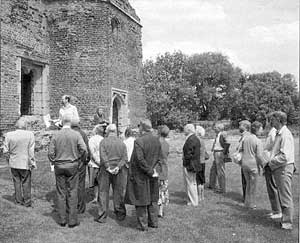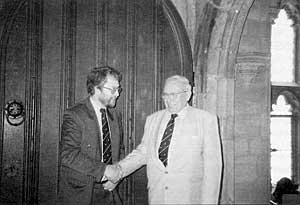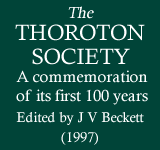The Society had connections in high places, and the doors of many a country house were opened, and frequently the resident owners led a guided tour. In 1945 at Newstead members were attended by Lady Chermside’s footmen in knee breeches, buckled shoes and powdered hair. As late as 1962 one member recalls visiting Prestwold Hall to be served crab and lobster by the resident butler and maids. Although Professor Wood noted in 1957 that criticism was sometimes levelled at the ‘picnic’ side of the Society’s efforts, the teas were legendary, partly because of Nora Witham’s links with the Women’s Institute movement across the county. Sometimes the food outran the appetites: one member recalls two elderly sisters who surreptitiously, or so they thought, filled paper bags with food to take home. If today’s teas are not quite so gracious, they remain a much appreciated part of the excursion.
Owners too, are still often in evidence. At Sandbeck Park a few years ago the Society arrived shortly before the Earl of Scarbrough, who appeared in an army helicopter wearing combat fatigues, which he kept on while conducting the guided tour. Nottinghamshire owners like Edmund Staunton, the Craven-Smith-Milnes’s and Mr and Mrs Brian Farr have also helped to make visits that little bit more special.
Finding new venues for excursions proves ever more difficult, and some places have been visited more than once. Southwell, to which the Society has been on six occasions, and Welbeck (five visits) have been the most frequently visited. Although excursions continue to be mainly to places of historic interest in Nottinghamshire and its adjoining counties, improved road communications have enabled more distant places to be visited on occasion, with the Society travelling as far as Ludlow, London and the Welsh Borders. Some rather different visits have included industrial sites, a bell foundry, a cream tea at Flintham with entertainment by Morris dancers, a ride on a steam train, and a tour of the Nottinghamshire open field village of Laxton on tractor-trailors. Sadly the heyday of Society excursions seems now to have passed: 150 members attended an excursion to Car Colston in 1977 and another forty had to be turned away. Numbers are no longer so high, and leaders do not need to employ the whistle used by Mr Holland Walker to summon members back to the buses!
 |
Excursion to Kirby Muxloe. 11 June 1994. |
Keith Train was succeeded as chairman in 1984 by Dr Rosalys Coope who had joined the Council in the mid 1 950s. An art historian by training and an architectural historian by inclination, she was the author of several books and a contributor to various publications including Transactions, where her studies of Newstead Abbey were particularly important. After eight years as chairman, she was succeeded in 1992 by Professor John Beckett, Professor of English Regional History at the University of Nottingham. As honorary secretary, Keith Train was succeeded by Michael Dobbin who held the post with distinction for eleven years. In 1981 John Childs was appointed assistant honorary secretary, and he succeeded Michael Dobbin the following year.
During his eight years as honorary secretary John introduced several innovations. One was the Annual Dinner. Three were held in the Royal Hotel and one at Kelham Hall. Guest speakers included the Director of Education for Nottinghamshire, John Fox, author Geoffrey Trease, Sir William Dugdale and Richard Alexander M.P. Attendances declined, but in 1989 the dinner was successfully relaunched as an Annual Luncheon. The first two, at the Albany Hotel in Nottingham, were addressed by Professor John Wilton-Ely and Mr Peter Harris. Later the venue was moved to the Bishop’s Great Hall at Southwell where it has been held in recent years with a variety of guest speakers including the Rt. Rev. Patrick Harris, Bishop of Southwell, Richard Craven-Smith-Milnes of Winkburn Hall, Mrs V. Jarvis of Doddington Hall, Lt. Col. G. Vere-Laurie of Carlton Hall, the architect Mr Derek Latham, and Dr Chris Brooke. For a number of years John Childs also organized a Christmas event in the Cathedral Hall with musical entertainment provided by, among others, Southwell Minster Choir and the Newstead Singers. He ran a ‘Secretary’s Excursion’ in August, with a distinctively social emphasis. The series was launched (an appropriate word in view of the heavy rain on the day) in 1984 with a visit to Flintham Hall. In subsequent years members could join a canal trip, a visit to Wedgwood and a very full day in London with the Houses of Parliament, a river trip to the Armada exhibition at Greenwich, the College of Arms and the Public Record Office among the attractions. The workload of the honorary secretary had become increasingly demanding and John did not seek re-election in 1989.
As a sign of the times, during Ann Hoskins’s subsequent tenure of the secretaryship the opportunity was taken to transfer the membership records onto computer, to eliminate confusion caused by the various categories of membership, and to create a more efficient system. Keith Goodman, who had been closely involved in transferring the records and setting up the system, became assistant honorary treasurer, then from 1992 treasurer with duties including those of membership secretary. The secretarial duties have been split to accommodate the increasing burden of work. The lecture programme, for example, has long been separately organized, for many years by Dr Maurice Caplan and more recently by Mrs Jean Nicholson.
Keith Train was succeeded as editor of Transactions in the mid 1970s by Adrian Henstock, Principal Archivist of Nottinghamshire County Council. He has steered the Transactions through various changes brought about by new printing technology and spiralling printing costs. He has worked successively with Alan Cameron, formerly of Nottingham University Manuscripts Department, and two archaeologists, Hazel Wheeler and now Dr Carol Allen. Like Standish and Wood before him, Adrian Henstock has served for more than twenty years in the post. The prestige enjoyed by Transactions continues to play an important part in the world-wide recognition of the Society’s work, with universities, libraries and learned societies from all five Continents being among the recipients.
Since 1960 the editors have included a section in Transactions called ‘Editors’ Notes’, one of the intentions being to bridge the gap between the ordinary member and the longer articles, another being to provide for comments on matters of interest and significant items of local news. From the same date the Annual Report and accounts were printed separately. In July 1992 a biannual newsletter was introduced, and today reports of excursions and lectures appear in this with, largely for financial reasons, the Annual Report reduced to a shadow of its former self!
 |
Annual Lunch 1996, Bishop’s Palace. Southwell. |
However, the Annual Report now carries information on the work of the Society’s representatives on other bodies. Both individually and collectively, members of the Society have sought to preserve the county’s historic buildings from destruction, not always successfully. In Nottingham, the Society campaigned to try to save Jessamine Cottages on Castle Road, Dorothy Vernon’s house on Friar Lane, the Black Boy Hotel, and Collin’s Almshouses. The loss of the latter, one of Nottingham’s finest buildings, aroused public concern and, as a result of representations to the City Council, the Society began to be at least advised of proposed demolition. More successfully it was represented at the Public Enquiry into the proposed demolition of Lambert’s Factory, and supported objections to early proposals for the new Inland Revenue building. From the 1 960s the Society was also represented on Conservation Area Advisory Committees in both city and county. In the city the CAAC was replaced in 1995 by a ‘Conservation Partners’ Forum’, and a Conservation Panel. In respect of listed buildings, and others in conservation areas, the Society provides the ‘correspondents’ for the Council for British Archaeology - it is one of six ‘statutory bodies’ which must be consulted - in commenting on listed building applications within the county. In these, and other ways, it plays a part in the preservation of our historic buildings and in the enhancement of the environment.
